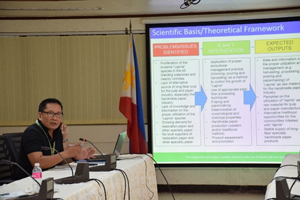 Locally known as “lapnis,” paper mulberry tree has gained notoriety due to its invasive characteristics, forming dense thickets that threatens the existence of local and endemic species. Specifically, the tree has been growing uncontrollably in Mt. Makiling, Los Baños, Laguna.
Locally known as “lapnis,” paper mulberry tree has gained notoriety due to its invasive characteristics, forming dense thickets that threatens the existence of local and endemic species. Specifically, the tree has been growing uncontrollably in Mt. Makiling, Los Baños, Laguna.
This led to the development of the project, “Assessment of the Coppicing Characteristics of Lapnis (Broussonetia papyrifera) as a Strategy for its Control and Management and Sustainable Utilization for Pulp and Paper Production.”
Spearheaded by Engr. Cesar Austria from the Forest Products Research and Development Institute of the Department of Science and Technology (DOST-FPRDI), the project aims to convert juvenile paper mulberry tree into high-value handmade paper. This has been one of the most profitable handicraft products of many neighboring countries.
Paper mulberry is classified as a large shrub or a small tree with a soft and brittle wood. It was introduced in the Philippines in the early 1930s as a reforestation species and as an alternative source of fiber. However, it can grow fast and spread easily via seed dispersal, primarily through birds and other animals that eat the fruit.
According to Engr. Austria, this study will provide information on the utilization of juvenile paper mulberry tree as source of alternative raw materials for the handmade paper industry as an additional source of livelihood opportunity for the local communities where these plants abound. By converting the tree species into paper products, its further spread and invasiveness can be controlled and managed.
The project is funded by the Philippine Council for Agriculture, Aquatic and Natural Resources Research and Development of the Department of Science and Technology (DOST-PCAARRD). It is expected to develop at least five paper products and two processes on harvesting and processing juvenile paper mulberry tree trunks, among others.
The project will run until March 2021 and will be closely monitored by DOST-PCAARRD.
